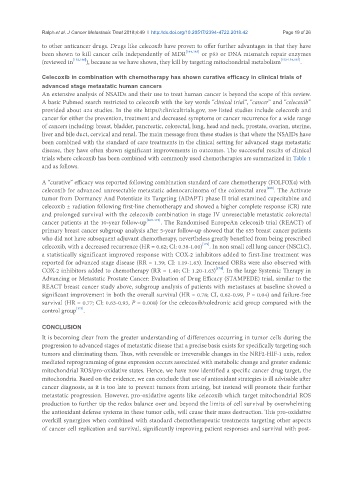Page 599 - Read Online
P. 599
Ralph et al. J Cancer Metastasis Treat 2018;4:49 I http://dx.doi.org/10.20517/2394-4722.2018.42 Page 19 of 26
to other anticancer drugs. Drugs like celecoxib have proven to offer further advantages in that they have
been shown to kill cancer cells independently of MDR [164,165] or p53 or DNA mismatch repair enzymes
(reviewed in [152,166] ), because as we have shown, they kill by targeting mitochondrial metabolism [152-154,167] .
Celecoxib in combination with chemotherapy has shown curative efficacy in clinical trials of
advanced stage metastatic human cancers
An extensive analysis of NSAIDs and their use to treat human cancer is beyond the scope of this review.
A basic Pubmed search restricted to celecoxib with the key words “clinical trial”, “cancer” and “celecoxib”
provided about 424 studies. In the site https//:clinicaltrials.gov, 359 listed studies include celecoxib and
cancer for either the prevention, treatment and decreased symptoms or cancer recurrence for a wide range
of cancers including: breast, bladder, pancreatic, colorectal, lung, head and neck, prostate, ovarian, uterine,
liver and bile duct, cervical and renal. The main message from these studies is that where the NSAIDs have
been combined with the standard of care treatments in the clinical setting for advanced stage metastatic
disease, they have often shown significant improvements in outcomes. The successful results of clinical
trials where celecoxib has been combined with commonly used chemotherapies are summarized in Table 1
and as follows.
A “curative” efficacy was reported following combination standard of care chemotherapy (FOLFOX4) with
celecoxib for advanced unresectable metastatic adenocarcinoma of the colorectal area [168] . The Activate
tumor from Dormancy And Potentiate its Targeting (ADAPT) phase II trial examined capecitabine and
celecoxib ± radiation following first-line chemotherapy and showed a higher complete response (CR) rate
and prolonged survival with the celecoxib combination in stage IV unresectable metastatic colorectal
cancer patients at the 10-year follow-up [169-172] . The Randomised EuropeAn celecoxib trial (REACT) of
primary breast cancer subgroup analysis after 5-year follow-up showed that the 655 breast cancer patients
who did not have subsequent adjuvant chemotherapy, nevertheless greatly benefited from being prescribed
[173]
celecoxib, with a decreased recurrence (HR = 0.62; CI: 0.38-1.00) . In non small cell lung cancer (NSCLC),
a statistically significant improved response with COX-2 inhibitors added to first-line treatment was
reported for advanced stage disease (RR = 1.39; CI: 1.19-1.63). Increased ORRs were also observed with
[174]
COX-2 inhibitors added to chemotherapy (RR = 1.40; CI: 1.20-1.63) . In the large Systemic Therapy in
Advancing or Metastatic Prostate Cancer: Evaluation of Drug Efficacy (STAMPEDE) trial, similar to the
REACT breast cancer study above, subgroup analysis of patients with metastases at baseline showed a
significant improvement in both the overall survival (HR = 0.78; CI, 0.62-0.99, P = 0.04) and failure-free
survival (HR = 0.77; CI: 0.63-0.93, P = 0.008) for the celecoxib/zoledronic acid group compared with the
[175]
control group .
CONCLUSION
It is becoming clear from the greater understanding of differences occurring in tumor cells during the
progression to advanced stages of metastatic disease that a precise basis exists for specifically targeting such
tumors and eliminating them. Thus, with reversible or irreversible changes in the NRF2-HIF-1 axis, redox
mediated reprogramming of gene expression occurs associated with metabolic change and greater endemic
mitochondrial ROS/pro-oxidative states. Hence, we have now identified a specific cancer drug target, the
mitochondria. Based on the evidence, we can conclude that use of antioxidant strategies is ill advisable after
cancer diagnosis, as it is too late to prevent tumors from arising, but instead will promote their further
metastatic progression. However, pro-oxidative agents like celecoxib which target mitochondrial ROS
production to further tip the redox balance over and beyond the limits of cell survival by overwhelming
the antioxidant defense systems in these tumor cells, will cause their mass destruction. This pro-oxidative
overkill synergizes when combined with standard chemotherapeutic treatments targeting other aspects
of cancer cell replication and survival, significantly improving patient responses and survival with post-

